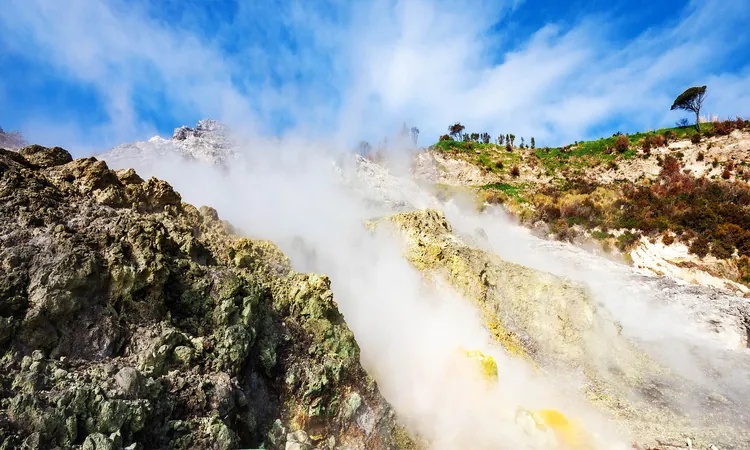
Is the Phlegraean Fields Supervolcano on the Verge of Eruption? The World Needs to Know!
2024-11-30
Author: Ying
Introduction
The Phlegraean Fields, a sprawling supervolcano located just west of Naples, Italy, are starting to show signs of increased volcanic activity, causing alarm bells to ring among scientists and residents alike. Analysts consider this region one of the top eight producers of volcanic carbon dioxide globally, which could have far-reaching implications.
Concerns at Solfatara Crater
Since 2005, the Solfatara crater within the fields has been a focal point of concern due to its rising gas emissions. Volcanologist Gianmarco Buono, who leads research at the Italian National Institute of Geophysics and Volcanology (INGV), is investigating the factors behind this troubling uptick. “Estimating the source of the carbon dioxide is crucial for accurately understanding the underlying magmatic and hydrothermal systems,” Buono explained.
What Is a Supervolcano?
But what defines a supervolcano? In layman's terms, a supervolcano is a massive volcanic system capable of unleashing eruptions thousands of times more potent than typical volcanoes. These colossal eruptions can spew over 1,000 cubic kilometers of material into the atmosphere, leading to catastrophic shifts in global climate and environment. One of the most famous examples is Yellowstone National Park in the United States.
Current Emissions and Implications
Currently, the Solfatara crater emits around 4,000 to 5,000 tons of carbon dioxide daily. To put this into perspective, that’s akin to the emissions generated by burning approximately 500,000 gallons of gasoline every day. Recent studies led by Buono’s team suggest that 20% to 40% of this carbon dioxide may originate from the breakdown of calcite in the surrounding rocks, while the remaining 60% to 80% can be traced back to magma underground.
Understanding Gas Release
Magma nearing the Earth's surface reduces pressure, leading to the release of gases like carbon dioxide and sulfur dioxide. Scientists monitor these volcanoes closely by tracking seismic activity, measuring ground deformation, and analyzing gases from fumaroles—openings that release steam and gases. Though an increase in gas emissions may indicate potential volcanic activity, it does not always lead to an eruption. Sometimes these emissions arise from hot fluids interacting with rocks rather than from magma itself.
Historical Context and Current Research
Research on the Solfatara crater has been ongoing since 1983. The gas emissions have shown significant changes, particularly after 2005, with rising temperatures and unusual chemical signatures indicating a potential shift in volcanic behavior. The alert level for this area has already risen to yellow, signaling increased activity without an immediate threat of eruption.
Seismic Activity and Ground Deformation
Not only are scientists observing changes in gas emissions, but they're also recording small earthquakes and noticeable ground deformation, which suggest the circulation of hot fluids beneath the surface. As these fluids interact with local rocks, they can enhance carbon dioxide production.
Significance of the Phlegraean Fields
The Phlegraean Fields have a volcanic history stretching back approximately 40,000 years, with the last eruption occurring in 1538. Understanding the source of volcanic emissions is more vital than ever, not just for the safety of the locals but for the ecological health of the planet. By discerning between magmatic and non-magmatic carbon dioxide sources, researchers can better predict volcanic activity and associated risks.
Conclusion
Buono's ongoing research provides crucial insight not only into Phlegraean Fields' dynamics but could also arm scientists with the knowledge to monitor volcanic regions worldwide effectively. In summary, unraveling the state of the Phlegraean Fields and Solfatara crater holds significant importance—not just in scientific terms but for everyone on Earth. With carbon dioxide emissions being sourced from both magma and underground rock interactions, the science community now has a clearer picture to help mitigate potential dangers. As this supervolcano stirs, vigilance remains key to preparing for whatever might come next.

 Brasil (PT)
Brasil (PT)
 Canada (EN)
Canada (EN)
 Chile (ES)
Chile (ES)
 España (ES)
España (ES)
 France (FR)
France (FR)
 Hong Kong (EN)
Hong Kong (EN)
 Italia (IT)
Italia (IT)
 日本 (JA)
日本 (JA)
 Magyarország (HU)
Magyarország (HU)
 Norge (NO)
Norge (NO)
 Polska (PL)
Polska (PL)
 Schweiz (DE)
Schweiz (DE)
 Singapore (EN)
Singapore (EN)
 Sverige (SV)
Sverige (SV)
 Suomi (FI)
Suomi (FI)
 Türkiye (TR)
Türkiye (TR)